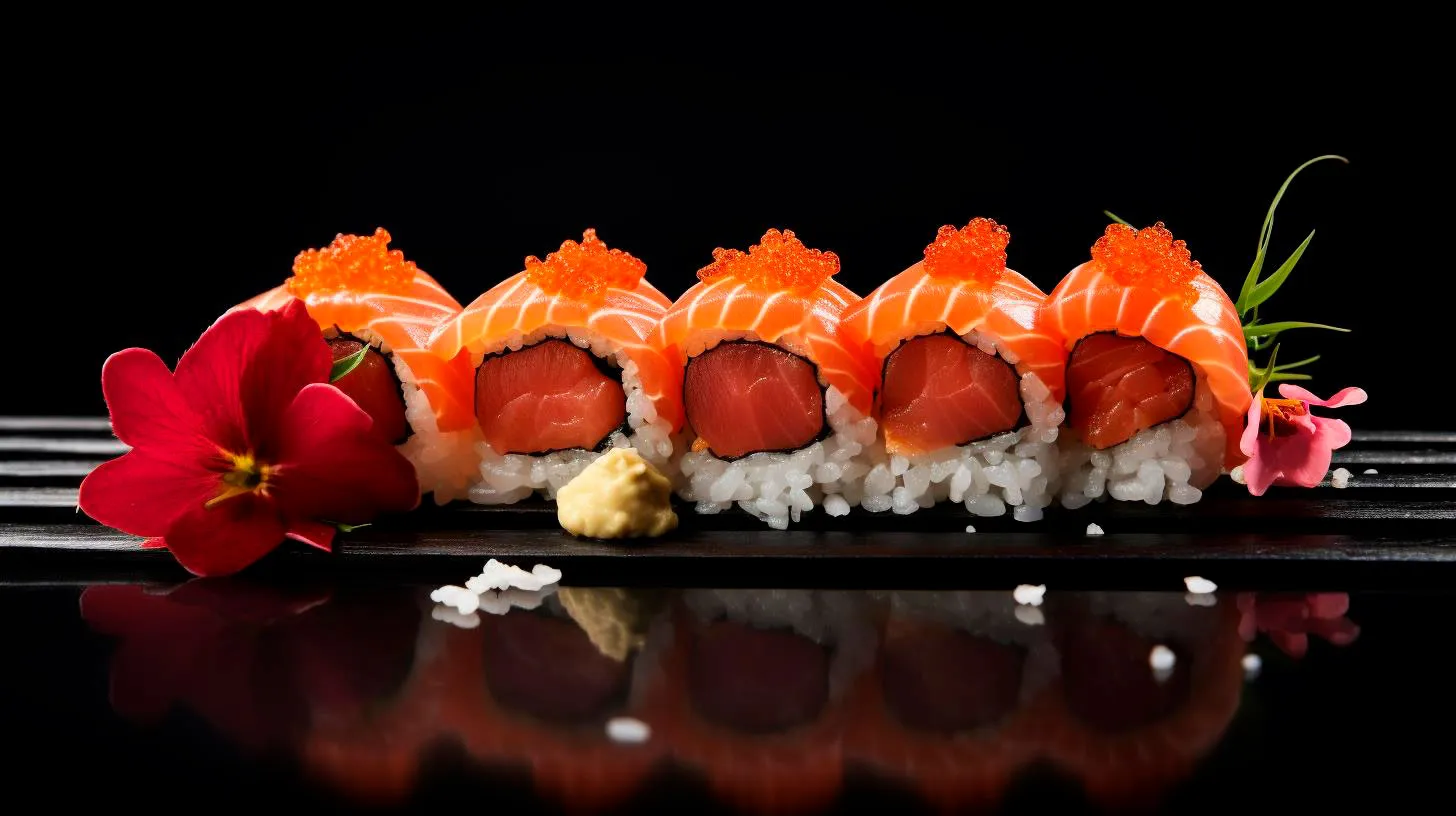Unveiling the Culinary Gems: Embark on a Delightful Sushi Trail
Embarking on a sushi trail allows you to uncover the hidden gems of this exquisite cuisine, exploring various sushi varieties and experiencing the true essence of Japanese gastronomy.
The World of Sushi: An Overview
Sushi, which originated in Japan, has evolved into a global sensation that has captured the hearts and taste buds of people worldwide. This traditional Japanese dish consists of vinegared rice combined with a variety of ingredients, including raw or cooked seafood, vegetables, and sometimes even tropical fruits.
- Sushi’s numerous variations: From nigiri and maki rolls to temaki and sashimi, sushi boasts a diverse range of variations, each offering its own unique blend of flavors and textures.
- Health benefits: Sushi is not only a treat for your taste buds but also offers numerous health benefits. It is rich in omega-3 fatty acids, lean proteins, and essential minerals, making it a nutritious option for those looking for a balanced diet.
- Artful presentation: One of the most visually appealing aspects of sushi is its presentation. Skilled sushi chefs meticulously craft each piece, considering color, texture, and arrangement, transforming it into a work of art.
The Sushi Trail: Exploring Culinary Delights
Embarking on a sushi trail takes you on a gastronomical adventure, where you can discover a plethora of unique flavors and ingredients. This culinary journey allows you to appreciate the delicate nuances of each sushi variation and experience the true essence of Japanese cuisine.
1. Nigiri: A Bite-Sized Delight
Nigiri sushi, featuring hand-pressed vinegared rice topped with various ingredients, is a classic favorite among sushi enthusiasts. Some popular nigiri variations include:
- Maguro (Tuna): Known for its rich, savory flavor and buttery texture, maguro nigiri is a staple in sushi restaurants worldwide.
- Hamachi (Yellowtail): With its distinct flavor and tender texture, hamachi nigiri offers a delightful experience.
- Ebi (Shrimp): This delicate and succulent shrimp nigiri is a must-try for seafood lovers.
2. Maki Rolls: Bite-Sized Creations
Maki rolls, also known as sushi rolls, are perhaps the most recognized form of sushi. They consist of vinegared rice, vegetables, and seafood, all rolled together in a sheet of nori seaweed. Here are some popular maki roll options:
- California Roll: A fusion of flavors, this roll typically includes avocado, crab meat, and cucumber.
- Spicy Tuna Roll: For those who enjoy a hint of spice, this roll combines tuna, spicy mayo, and cucumber.
- Vegetable Roll: A vegetarian option filled with fresh and crunchy vegetables, providing a burst of flavors.
3. Temaki: A Handheld Delicacy
Temaki, meaning “hand roll,” is a cone-shaped sushi that’s made by wrapping nori seaweed around a mix of rice, seafood, and vegetables. It offers a unique and interactive dining experience. Some popular temaki options include:
- Salmon Skin Temaki: Made with crispy, seasoned salmon skin and an assortment of fresh ingredients, this temaki roll offers a delightful crunch.
- Spicy Scallop Temaki: Combining tender scallops and spicy mayonnaise, this roll delivers a harmonious blend of flavors.
- Beef Teriyaki Temaki: A fusion of Japanese and Western flavors, this roll features thinly sliced beef teriyaki along with rice and vegetables.
Key Takeaways: Discover the Sushi Trail
Embarking on a sushi trail allows you to immerse yourself in a world of tantalizing flavors and cultural exploration. Here are some key takeaways:
- Variety and versatility: Sushi offers an extensive range of options to cater to all taste preferences, from raw to cooked, vegetarian to seafood, and mild to spicy.
- Cultural experience: Exploring the world of sushi provides an opportunity to delve into Japanese culture and culinary traditions, appreciating the artistry and precision involved.
- Health-conscious choice: Sushi can be a nutritious and well-balanced meal option, providing essential nutrients and healthy fats.
Embark on a sushi trail and satisfy your taste buds with the delicate flavors and textures of this culinary gem. Experience the artful presentation and uncover the hidden delights of Japanese gastronomy as you indulge in this exquisite culinary journey.
Gastronomic Adventures Await: Discover a World of Culinary Pleasures through Sushi
The Sushi Culture
Sushi is not just a meal; it is a representation of Japanese culture and tradition. Every aspect, from the selection of ingredients to the technique of preparation, is meticulously carried out to create an unforgettable dining experience. Here are some key takeaways on the sushi culture:
- Meticulous Preparation: Sushi chefs undergo years of rigorous training to master the art of sushi-making. Their attention to detail ensures each piece is a work of art.
- Seasonal Ingredients: Sushi revolves around the use of fresh, seasonal ingredients. Chefs carefully select the finest fish, vegetables, and other elements to deliver the perfect balance of flavors.
- Respect for Tradition: Sushi-making is deeply rooted in tradition, with techniques passed down through generations. It is a celebration of history and heritage.
Types of Sushi
Sushi is a versatile cuisine that offers a wide variety of options to cater to different tastes and preferences. Here are some popular types of sushi:
- Nigiri: A classic sushi style consisting of a small mound of rice topped with a slice of raw or cooked fish. Nigiri showcases the simplicity and essence of sushi.
- Maki: Maki sushi is the familiar rolled sushi, with ingredients such as fish, vegetables, and rice wrapped in seaweed. It is a great option for those new to sushi.
- Sashimi: Sashimi consists of thin slices of raw fish or seafood served without rice. It highlights the natural flavors and textures of the ingredients.
- Temaki: Temaki, also known as hand rolls, are cone-shaped sushi rolls filled with a variety of ingredients. They are perfect for an interactive dining experience.
Health Benefits of Sushi
Sushi is not only a treat for your taste buds but also offers several health benefits. Here’s why indulging in sushi can be good for you:
- High in Nutrients: Sushi is an excellent source of lean proteins and essential nutrients like omega-3 fatty acids, vitamins, and minerals. It provides a nutritious boost to your diet.
- Heart-Healthy: The omega-3 fatty acids present in fish contribute to heart health, reducing the risk of heart disease and promoting overall cardiovascular well-being.
- Low in Calories: Sushi can be a healthy option for weight management as it is generally low in calories. Opt for sushi rolls with vegetable fillings or lean fish for a lighter meal.
- Rich in Antioxidants: Ingredients such as seaweed, ginger, and wasabi are known for their antioxidant properties, which help combat inflammation and promote healthy cell function.
Exploring Sushi in Your City
No matter where you are, chances are you can find a sushi bar or restaurant nearby. With the popularity of sushi on the rise, more and more eateries are offering this unique culinary experience. Here are some tips for exploring sushi in your city:
- Research and Reviews: Take some time to read reviews and explore different sushi spots in your area. Look for establishments with a reputation for quality and authenticity.
- Experiment with Flavors: Sushi offers a plethora of flavors and combinations. Be adventurous and try different types of sushi to discover your personal favorites.
- Engage with the Sushi Chef: Interacting with the sushi chef can enhance your dining experience. They can provide insights into the ingredients, techniques, and even suggest personalized creations.
- Embrace the Traditions: Embrace the cultural aspect of sushi dining by observing sushi etiquette, such as using chopsticks, dipping sushi correctly in soy sauce, and respecting the chef’s craftsmanship.
Sushi is not just a meal; it is a journey that takes your taste buds on an extraordinary adventure. With its rich cultural history, diverse flavors, and health benefits, sushi has captured the hearts and palates of food enthusiasts worldwide. Embark on a gastronomic journey and uncover the endless delights that await you in the world of sushi.
From Sashimi to Maki: A Gourmet Journey through Umami-filled Delicacies
Discovering Umami
Umami, often referred to as the fifth taste, is a savory flavor that enriches the overall taste experience. While sweet, sour, bitter, and salty were the traditional four recognized tastes, umami has gained recognition for its unique ability to enhance flavors. In Japanese cuisine, umami is a crucial element that creates a harmonious balance of tastes and elevates the dining experience.
Umami is derived from naturally occurring compounds such as glutamate and nucleotides. These compounds can be found in various ingredients used in Japanese cooking, including kelp, mushrooms, soy sauce, and fermented products like miso and soybean paste.
Key Takeaway:
- Umami is the fifth taste, adding a savory element to dishes.
- Natural compounds like glutamate and nucleotides contribute to umami flavor.
- Japanese cuisine utilizes ingredients rich in umami for a delightful dining experience.
Sashimi: Pure Elegance on a Plate
One of the jewels of Japanese cuisine, sashimi showcases the epitome of freshness and purity. Served as thinly sliced pieces of raw fish or seafood, sashimi preserves the delicate flavors of the main ingredient. The presentation is intricate and visually appealing, taking you on a sensory journey even before you taste the dish.
The most commonly used fish for sashimi include tuna, salmon, and yellowtail. Each fish has its unique texture and taste, ensuring a diverse range of experiences for every sashimi lover. The accompanying soy sauce and wasabi provide a burst of flavor while respecting the simplicity of the dish.
Key Takeaway:
- Sashimi offers a pure and fresh taste experience.
- Various fish types can be used, such as tuna, salmon, and yellowtail.
- Soy sauce and wasabi complement the flavors of sashimi.
Maki: The Art of Rolling
Maki, commonly known as sushi rolls, is a delightful combination of flavors and textures wrapped in nori seaweed and rice. With endless possibilities for fillings, maki allows for creativity and experimentation. From classic combinations like salmon and avocado to innovative fusions of tempura and spicy mayo, there is a maki roll for everyone.
Not only are maki rolls a treat for the taste buds, but their colorful presentation adds to the overall dining experience. The precision required to roll and slice the maki into bite-sized pieces is a testament to the artistry of Japanese culinary techniques.
Key Takeaway:
- Maki rolls combine diverse flavors and textures.
- Customizable fillings offer endless options for experimentation.
- The visual presentation of maki enhances the dining experience.
Unveiling the Culinary Secrets
Japanese cuisine is not only about the flavors but also the culture, tradition, and techniques behind it. The attention to detail, appreciation for natural ingredients, and pursuit of culinary excellence are fundamental principles in Japanese cooking.
Through centuries of refinement, Japanese culinary masters have honed their skills to create dishes that are both visually stunning and immensely satisfying. From the delicate knife work of a sushi chef to the precise and balanced flavors in every bite, Japanese cuisine is a work of art.
Key Takeaway:
- Japanese cuisine embodies culture, tradition, and culinary mastery.
- Attention to detail and exceptional skills are integral to Japanese cooking.
- Japanese cuisine is a fusion of artistry and delicious flavors.
Embark on a gourmet journey and immerse yourself in the world of Japanese cuisine. From the subtle elegance of sashimi to the creative combinations of maki rolls, explore the umami-filled delicacies that will leave you craving for more.
The Art of Umami: Exploring the Rich Flavors of Sushi
The Umami Sensation
Umami, often referred to as the fifth taste, is a savory flavor that was scientifically recognized in the early 20th century by a Japanese chemist, Kikunae Ikeda. It is derived from glutamic acid, an amino acid found in various foods, including seaweed, soy sauce, and fish. Umami adds a unique depth of flavor to dishes, enhancing the overall taste and creating a pleasantly satisfying experience for the palate.
When it comes to sushi, umami plays a significant role in elevating its taste. The combination of vinegared rice, fresh fish, and other ingredients enhances umami flavors, making each bite a delightful experience. The secret lies in the craftsmanship of sushi chefs who strive to strike the perfect balance of flavors.
A Symphony of Flavors
Sushi is more than just raw fish and rice; it is an art form that marries the flavors and textures of different ingredients. Let’s explore some key aspects that contribute to the unique umami experience in sushi:
- Fish Selection: Freshness is crucial in sushi, as it enhances the umami flavors. Oily fish like salmon and mackerel have higher levels of umami, while the delicate flavor of tuna adds depth.
- Rice Preparation: The perfectly cooked and seasoned rice in sushi acts as a canvas for umami. A good sushi chef knows how to strike the right balance of vinegar, salt, and sugar, enhancing the overall experience.
- Seaweed: Nori, the seaweed used to wrap sushi rolls, possesses its own umami taste. When combined with the other ingredients, it further enhances the overall flavor profile.
- Condiments and Sauces: Soy sauce, wasabi, and pickled ginger are commonly served alongside sushi. These condiments not only add an extra layer of umami but also provide contrasting tastes that complement the sushi experience.
The Health Benefits of Umami
Aside from its mouthwatering flavors, umami also brings some health benefits to the table. Here are a few reasons why incorporating umami-rich sushi into your diet can be advantageous:
- Source of Protein: Fish used in sushi is an excellent source of lean protein, which supports muscle growth and repair.
- Omega-3 Fatty Acids: Fish like salmon and tuna are rich in omega-3 fatty acids, which promote heart health, improve brain function, and reduce inflammation.
- Vitamins and Minerals: Sushi ingredients, such as seaweed and vegetables, provide essential vitamins and minerals, including iodine, vitamin C, and antioxidants.
- Low in Calories: Sushi can be a low-calorie option compared to other fast food choices, making it a healthier alternative.
- Rich in Fiber: Sushi rolls often include vegetables like cucumber and avocado, which are high in fiber, promoting digestive health.
The Key Takeaways
Sushi is not only a delectable dish but also an art form that highlights the unique umami flavors. To summarize the key points of this article, consider the following takeaways:
- Umami is the fifth taste, contributing a savory and satisfying flavor to dishes.
- Sushi chefs utilize a combination of fresh fish, vinegared rice, seaweed, and condiments to create an exceptional umami experience.
- Incorporating umami-rich sushi into your diet offers various health benefits.
- Sushi is a creative combination of flavors, textures, and presentation that truly delights the senses.
Next time you savor a piece of sushi, take a moment to appreciate the artistry and complex flavors intertwined within each bite. Embrace the umami experience and let it transport you to the vibrant and diverse world of Japanese cuisine.



